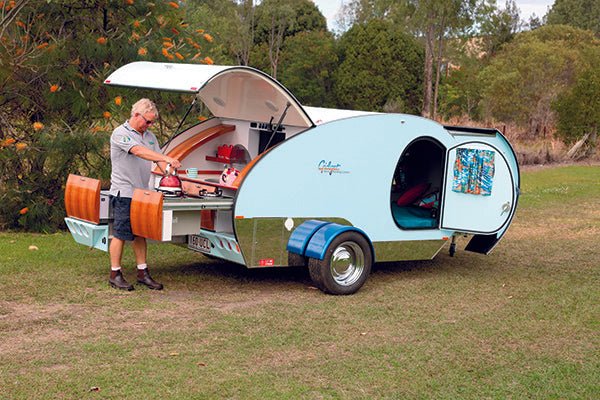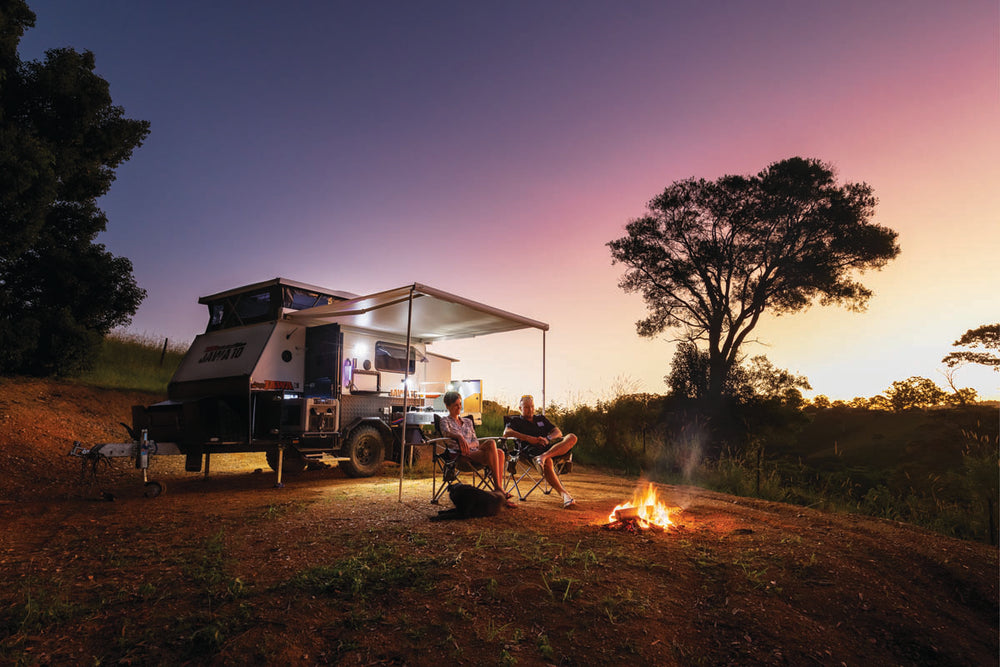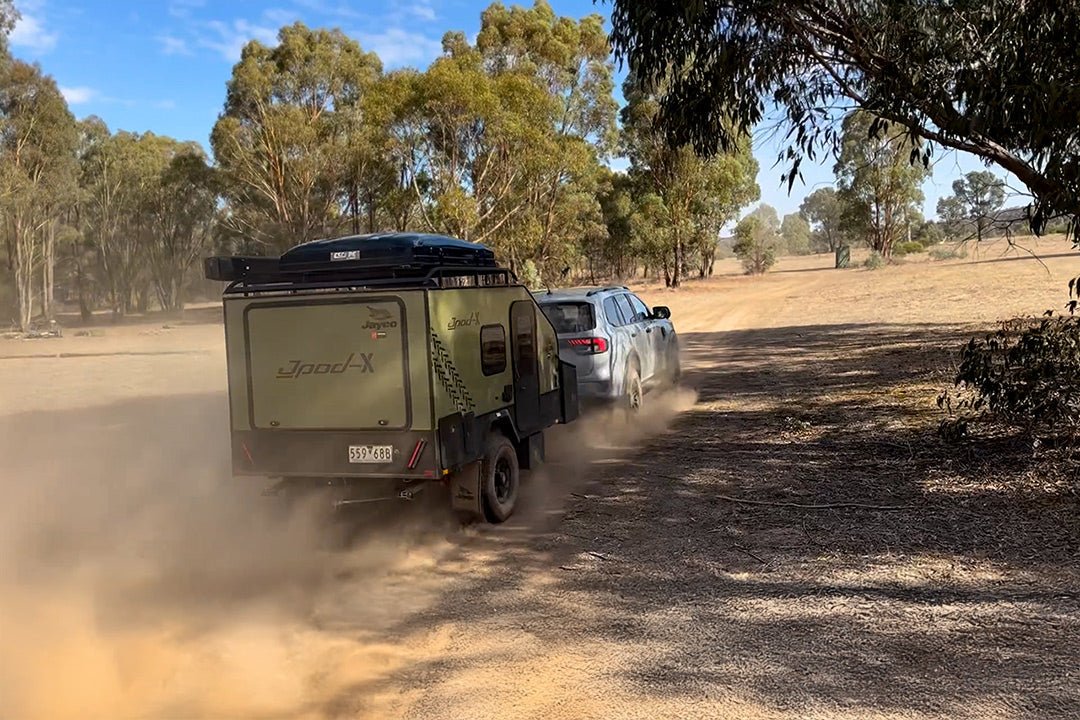Gidget Noosa Review

Movie buffs might well remember the name Gidget. For many, it conjures up an image of California beaches and surfing in Hawaii because of the early 60s Gidget series of films and musicals. Not by coincidence, it also happens to be the name of a Brisbane-based manufacturer of retro teardrop campers. I say not by coincidence because someone at Gidget the manufacturer is a fan of Gidget the film genre.
Continuing the beach theme, except for a new offroad model, the Gidget teardrops have names like Bells, Bondi and Noosa, just to get you in the mood. I don’t have a surfboard but I decided to take the Noosa for a run anyway.
DESIGN & CONSTRUCTION
The Gidget Noosa might look a bit like a toy, but it’s not. And while I know, given the Noosa has a Tare weight of just 755kg, my Range Rover tow vehicle was massive overkill, the Noosa is designed for a bit of fun, so why not? You’ll find you can easily tow the Noosa with a huge range of much smaller tow vehicles, due to its extremely light weight.
In Australia, teardrop campers stand out for a number of reasons; they are different to the rest of the caravan crowd, they are very lightweight, and they have a very retro, appealing look about them – but we all know appearance isn’t everything.
The first thing to know is that Gidget teardrops are fully designed and built in Australia using, for the most part, component suppliers that are very familiar names and also using Gidget’s own purpose-engineered fittings.
70x50mm (3x2in) RHS steel is used for the galvanised chassis but it’s not quite a full box section design because the body work sits around the chassis, not above it. Given the small size of the teardrop, that’s a necessary concept that works well – using the space between the chassis rails. The ball coupling at the pointy end is a conventional addition, as is the jockey wheel, but there’s no handbrake – Gidget trailers are fitted with electric brakes only.
Conventional leaf spring suspension is used for the 15in steel wheels which, unlike most caravans, are fitted outside the van body and, therefore, use the retro-looking mudguards which give the Gidget teardrop much of its character.
INSIDE-OUT
There’s something quite unique about the Noosa’s body structure. It’s made of a mixture of fibreglass composite/ply timber walls and full-moulded fibreglass components but it comes with a slide-out which is built into the front wall of the camper.
A tour around the Gidget factory reveals that not only do the employees take a great deal of pride in their work but that the teardrop trailers are built using the inside-out technique. That means all the cabinetry work is fully assembled before fitting to the trailer and then the bodywork is fitted last.
KITCHEN
The Noosa has quite a simple layout with an almost full-size kitchen fitted to the rear of the camper outside, and a surprisingly large lounge/bedroom area up front. The area available is, of course, greatly enhanced when the slide-out is opened. Custom-made doors are fitted to each side of the camper body and there are two standard opening double-glazed windows fitted to each side of the slide-out plus a skylight in the roof, which doesn’t open, as well. A slimline 110W solar panel is hidden on the slide-out roof.
Amazingly, in addition to all of the above, there are also two external storage bins fitted. Okay, so they are both dedicated; the rear offside one has a 4kg gas cylinder and the nearside one houses the porta-potti and external shower, but both are a neat fit.
Getting access to the kitchen is just a matter of lifting the rear hatch – gas struts make that a lightweight job. First impressions are everything and both the kitchen layout and the curved timber finish on the upper and lower parts of the bench space are a thing of beauty. The timber is the real deal, too – not a laminate.
Fitted to the upper part of the kitchen bench is a round stainless steel sink, shelves on both sides plus a centre section which contains not only essential electricals (12V switches, charger points and mains power point) but also a rotating entertainment console which has a flatscreen TV on one side and a radio on the other. So what’s interesting about the shelves is that they are all lipped and fitted with non-slip material, so that nothing packed therein moves around, even when travelling.
When it comes to the kitchen, I could just say that there’s a slide-out kitchen on the right-hand side, a slide-out chest-style fridge on the left-hand side and a large drawer with a second drawer within. And there is all that, but putting it like that doesn’t really do it justice. The toughened glass cooktop is built to a Gidget design, something that has necessitated a gas compliance certificate. That design includes a special valve that shuts off the gas should the cooktop slide be closed with the burners still on.
THE BOTTOM LINE
Although the Noosa is lightweight and small, it is definitely punching well above its weight and that is not only indicated by strong Australian interest but from overseas as well, particularly the USA (where Gidget has an office) and New Zealand.
I’m going to let you in on a little secret here, although the Gidget Noosa is definitely an on-road model, there’s a purpose-designed offroader called the Brumby on the way!
Was I impressed with the Gidget Noosa retro teardrop camper? You bet! The camper has a distinctive US flavour about it, but the general use of space, fitout and finish has a much more European feel about it. That’s a combination that works very well here.
The Noosa is indeed ‘glamping’ in style.
Measuring up
Pros
- Small camper but very effective use of space
- Large kitchen
- Inside lounge area for wet/cold weather
- Good-size bed
- Lightweight traveller
- Good general storage
- Well put together
- A joy to look at
Cons
- No handbrake
- Wheel chocks required
- In insect prone areas, a dome gazebo or similar would be handy







